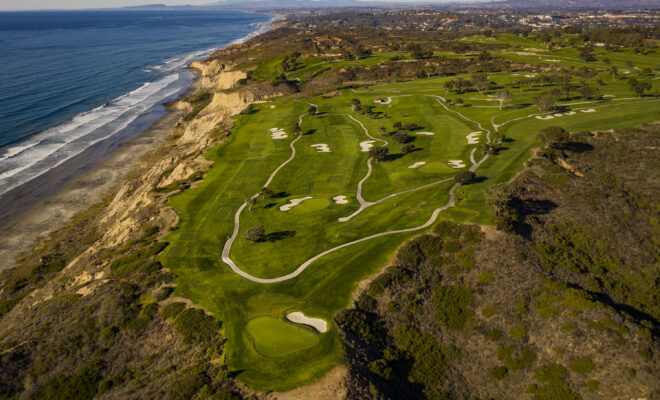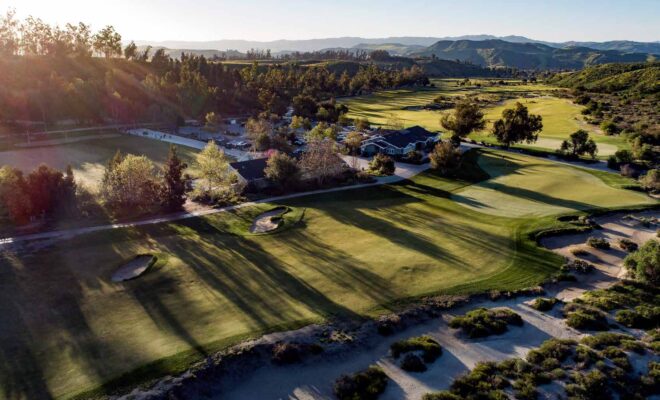The U.S. Open Setup: A Q&A With The USGA’s Jeff Hall

JEFF HALL still remembers the roar. When Tiger Woods birdied the 18th hole to force a Monday playoff with Rocco Mediate during the 2008 U.S. Open at Torrey Pines, the crowd reaction was unforgettable. “I was just outside the scoring area in the cart barn and near Rocco, who was watching on TV,” said Hall, the USGA’s managing director, Rules and Open Championships. “Even 100 yards away, you knew what happened.” Hall and the USGA are now preparing for the U.S. Open’s return to the South Course June 17-20. He shares his thoughts on the course setup, graduated rough, and some new tees.
FORE: Will the South Course set up differently this year than in 2008?
HALL: I’m not sure there is going to be a huge difference. The city of San Diego has made a tremendous investment in Torrey Pines, including a significant infrastructure boost (bringing in new irrigation and drainage systems) in 2019. That has impacted what superintendent Rich McIntosh has been able to do with watering, especially right now with the transition from overseeded rye grass to the kikuyu grass that will be in place by June.
What impact will four new championship tees have on the layout?
The tee on No. 4 was shifted closer to the ocean (as was the fairway). On 17, the tee was shifted to the left and lower than the existing tee, so it offers a slightly different angle. There are new tees on 10 and 15 that will add yardage. The 10th went from 415 yards in 2008 to 449 yards this year. On 15, we established a new tee at 513 yards, but the fairway there was also widened slightly. In June, that hole should play with a slightly helping crosswind from the left. So it’s available, but we’ll also likely use the existing tee (478 yards) some of the days as well.
You attended the Farmers Insurance Open this past January at Torrey. What course insights did you glean then?
We spent a lot of time watching the drive zone on the 10th hole because there’s quite a pitch there from left to right. We made a decision to widen that fairway slightly on the right to provide a little more room, with the anticipation that conditions will be dryer and firmer in June. We also looked at the reconfigured fairway on the fourth hole to get a sense of how guys were approaching the hole, but we also recognized that it will be a different golf course in June. What we are hearing from the PGA Tour guys generally is that it’s a very challenging course; you just don’t pretend your way around Torrey Pines South.
What effect can “June Gloom” have on course conditions?
How long it hangs around and what kind of moisture it’s bringing into the atmosphere can have an effect. Cooler temperatures can mean the ball doesn’t go as far. In that case (or with the Santa Ana winds), we may perhaps adjust a few tee locations, but we have identified alternative tees we could use from a strategy standpoint. You may have a plan that you would like to execute, but sometimes you get out there and say that’s not going to work, so we need to do this. We’ll be prepared for that.
We also looked at the reconfigured fairway on the fourth hole to get a sense of how guys were approaching the hole, but we also recognized that it will be a different golf course in June. What we are hearing from the PGA Tour guys generally is that it’s a very challenging course; you just don’t pretend your way around Torrey Pines South.”
Will graduated rough be used on all nonpar 3s?
There will be some holes with no graduated rough, like the second, a very short par 4. There’s also a pretty good chance that on the par 5s, there may not be graduated rough just to put a premium on driving the ball in the fairway. But a hole like 12 is a really good example. That is a real big par 4 that will generally play into some type of hurting breeze. We might have a bit more graduated rough there than maybe on the first hole. We’re going to start with three inches of primary rough, and then the balance of the rough will be closer to five inches. I anticipate we will adjust those heights either up or down depending on what we see when we get there. We will check the density and moisture content to see where that rough will go.
How will the green contours affect the green speed?
We don’t want excessive green speeds, but we want to make sure there is a premium on touch, whether it’s while playing shots around the greens or putting. Right now we would like the majority of the golf played on the greens for a particular day be in the area of 13 feet (as measured by the Stimpmeter). With a seaside golf course you have to be concerned with wind and how exposed some of the greens can be, although that would seem to be a bit more out of character at Torrey than at Pebble Beach, where you can get days of howling breezes. There are a few greens on the South Course that have a little more slope than others; No. 13 is a good example. The green on that par 5 has quite a bit of back-to-front slope, so the speed really needs to be monitored there.
In 2018 the USGA scrapped the 18-hole playoff format (last used in 2008) for a two-hole aggregate playoff. Which two holes on the South Course will be used if needed this year?
We have not yet arrived at which holes would be used. I would contemplate that the 18th hole will be one of the two. We haven’t quite talked through that yet.










